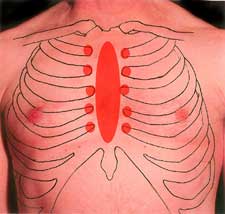
Your doctor will also ask you about your past medical history and check if you have any risk factors that can increase your chance of getting heart disease, such as smoking, diabetes, high blood pressure, high cholesterol, or if you are older than 50 years.

It may then be called ‘non-specific’ chest pain. Sometimes it is not possible to identify the cause for chest pain after a thorough medical assessment.
#DEEP UPPER CHEST DISCOMFORT SKIN#
shingles – a blistering skin rash with pain.costochondritis – inflammation of joints in your chest.chest wall injury such as muscle strain or a bruised or broken rib.gallstones or pancreatitis (inflammation of the pancreas).heartburn, indigestion or gastroesophageal reflux disease (GORD).ruptured oesophagus – this can happen after retching, vomiting or medical procedures.pneumothorax (collapsed lung) – air trapped in between your lung and chest wall.pulmonary embolus – a clot in one of the blood vessels in your lungs.aortic dissection – a tear in your main artery (the aorta).pericarditis – inflammation of the lining around your heart.

angina – chest pain that occurs when the blood supply to the muscles of your heart is restricted.heart attack – blockage of one of the blood vessels supplying your heart.Some of the more serious causes of chest pain caused by problems of your heart and lungs include:

However, even mild chest tightness or discomfort can be the first sign of something more serious such as a heart attack or a blood clot in your lung. Most of the time chest pain is not caused by heart problems, especially if you are younger than 40 and otherwise well.
#DEEP UPPER CHEST DISCOMFORT PROFESSIONAL#
You need to talk to a healthcare professional who can give you proper advice. Also, do not ask for advice from family or friends. Ring Healthline 0800 611 116 for advice now if you are unsure what to do.ĭo NOT diagnose yourself from this information or any information you find on the internet.


 0 kommentar(er)
0 kommentar(er)
